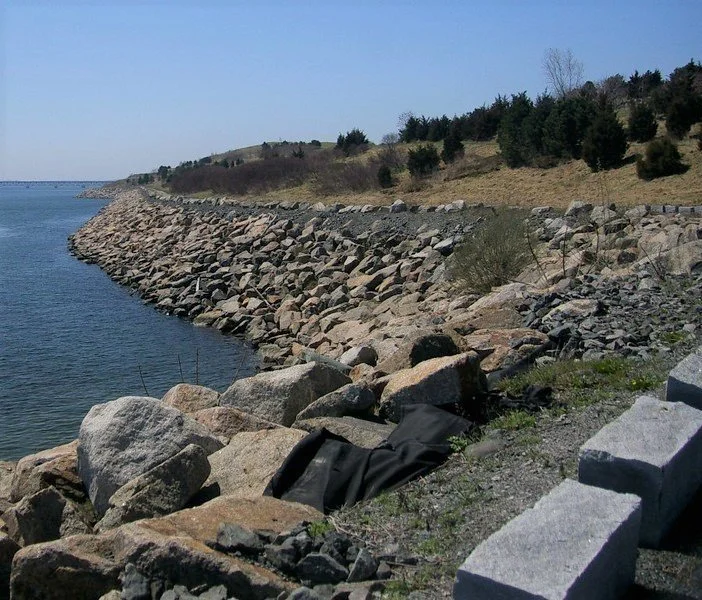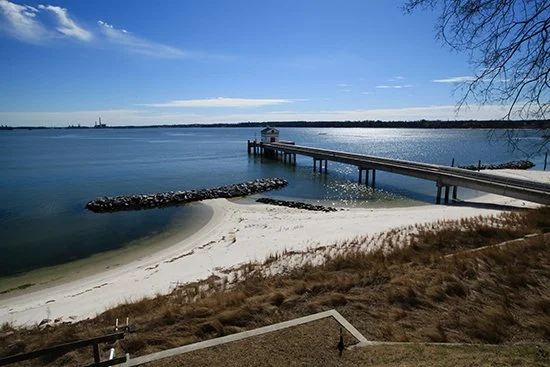Don’t Hold Back: Washington’s Shoreline Restoration Embraces the Tide
By Will Mixon, Marine Biology ‘26
Mesh bags filled with stones hold back the waves, creating a harsh division of ecosystems (Image credit: Daniella Rieken).
Waterfront property is a valuable asset that gives us the ability to live and work by the sea. To protect these investments from being washed away by nature’s tireless forces, we have fortified the shore with sturdy barriers. The long-sought practice of preventing erosion is called coastal armoring and can take on many forms, from solid concrete barriers to piles of riprap. Such actions are widespread in Washington State, where more than 25% of the state’s 2,500 miles of shoreline have had some form of wave-breaking modification. However, waterfront development also spurs changes in coastal ecosystems that can harm marine life and lower water quality.
Though effective at fulfilling their intended purpose, these man-made structures often produce negative impacts on intertidal ecosystems including decreased biodiversity, halting the deposition of wrack, and increased sediment erosion below the armoring. Implications of these impacts can be significant. For example, the transfer of erosion below the waterline degrades nearshore ecosystems like eelgrass meadows, which serve as critical nursery habitats for juvenile salmon.
Riprap is a common armoring technique that uses large stones reinforced with earth (Image credit: Massachusetts Department of Environmental Protection/Flickr).
To offset the consequences of armoring, organizations such as the Washington Department of Fish and Wildlife are working to promote a ‘living shoreline’ which simultaneously protects property and preserves ecosystem function. One key way they are accomplishing this is by restoring critical coastal habitat and converting armored shorelines back to their original state. However, living shorelines are not just surrendering the beaches to erosion once more. They include the new eco-friendly buffers that will still halt erosion, such as logs anchored onto the shore, restored natural reducers of wave action like reeds and seagrasses, and reconfigured armoring to create sheltered beaches.
Restoration efforts, like living shorelines, received valuable support during Biden’s administration. Disbursements made since 2022 by the Bipartisan Infrastructure Law funded a menagerie of reconstruction projects that will modernize the nation's coastline. The National Oceanic and Atmospheric Administration granted more than $485 million since 2022 to projects seeking to improve coastal resilience and awarded $78 million of that in Washington State. NOAA has also partnered with the National Fish and Wildlife Foundation since 2018 to fund habitat restoration projects that enhance resistance against intense storms and flooding.
Shoreline restoration is a nuanced effort that requires a variety of strategies. Some funding is being used to perform large-scale armor removal in rivers and bays along Washington’s highways. Projects like this take place on public land with significant government support, but a primary challenge is that much of the state’s hardened coastline is on private property. In these cases, restoration relies on the involvement from the public. Outreach work done by the WDFW educates homeowners about the ecological effects of their armored shorelines and proposes personalized solutions.
It is important to be able to live by the sea without compromising the resources we seek from it. While armoring may have great benefits for protecting our terrestrial property, the extent of its use disrupts critical habitat. Converting to sustainable promotes biodiversity and the abundance of commercially valuable species. Because of this, shoreline restoration is a long term investment in the prosperity of coastal communities.




